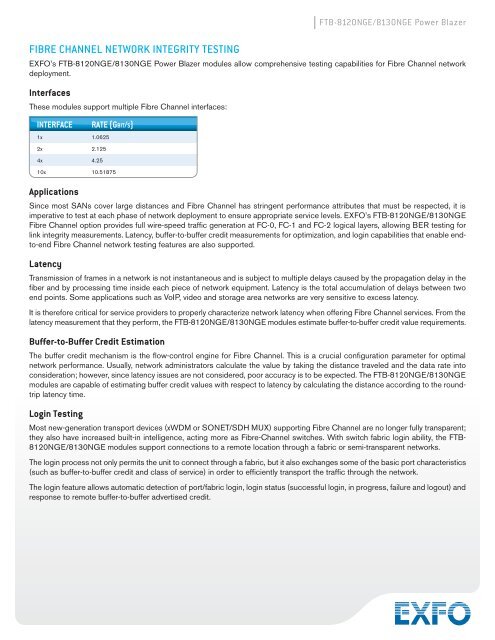FTB-8120NGE/8130NGE Power Blazer - Advanced Test Equipment ...
FTB-8120NGE/8130NGE Power Blazer - Advanced Test Equipment ...
FTB-8120NGE/8130NGE Power Blazer - Advanced Test Equipment ...
Create successful ePaper yourself
Turn your PDF publications into a flip-book with our unique Google optimized e-Paper software.
fiBrE channEl nEtWorK intEgrity tESting<strong>FTB</strong>-<strong>8120NGE</strong>/<strong>8130NGE</strong> <strong>Power</strong> <strong>Blazer</strong>EXFO’s <strong>FTB</strong>-<strong>8120NGE</strong>/<strong>8130NGE</strong> <strong>Power</strong> <strong>Blazer</strong> modules allow comprehensive testing capabilities for Fibre Channel networkdeployment.InterfacesThese modules support multiple Fibre Channel interfaces:INTERFACE1x 1.06252x 2.1254x 4.25ApplicationsSince most SANs cover large distances and Fibre Channel has stringent performance attributes that must be respected, it isimperative to test at each phase of network deployment to ensure appropriate service levels. EXFO’s <strong>FTB</strong>-<strong>8120NGE</strong>/<strong>8130NGE</strong>Fibre Channel option provides full wire-speed traffic generation at FC-0, FC-1 and FC-2 logical layers, allowing BER testing forlink integrity measurements. Latency, buffer-to-buffer credit measurements for optimization, and login capabilities that enable endto-endFibre Channel network testing features are also supported.LatencyTransmission of frames in a network is not instantaneous and is subject to multiple delays caused by the propagation delay in thefiber and by processing time inside each piece of network equipment. Latency is the total accumulation of delays between twoend points. Some applications such as VoIP, video and storage area networks are very sensitive to excess latency.It is therefore critical for service providers to properly characterize network latency when offering Fibre Channel services. From thelatency measurement that they perform, the <strong>FTB</strong>-<strong>8120NGE</strong>/<strong>8130NGE</strong> modules estimate buffer-to-buffer credit value requirements.Buffer-to-Buffer Credit EstimationThe buffer credit mechanism is the flow-control engine for Fibre Channel. This is a crucial configuration parameter for optimalnetwork performance. Usually, network administrators calculate the value by taking the distance traveled and the data rate intoconsideration; however, since latency issues are not considered, poor accuracy is to be expected. The <strong>FTB</strong>-<strong>8120NGE</strong>/<strong>8130NGE</strong>modules are capable of estimating buffer credit values with respect to latency by calculating the distance according to the roundtriplatency time.Login <strong>Test</strong>ingRATE (GBIT/S)10x 10.51875Most new-generation transport devices (xWDM or SONET/SDH MUX) supporting Fibre Channel are no longer fully transparent;they also have increased built-in intelligence, acting more as Fibre-Channel switches. With switch fabric login ability, the <strong>FTB</strong>-<strong>8120NGE</strong>/<strong>8130NGE</strong> modules support connections to a remote location through a fabric or semi-transparent networks.The login process not only permits the unit to connect through a fabric, but it also exchanges some of the basic port characteristics(such as buffer-to-buffer credit and class of service) in order to efficiently transport the traffic through the network.The login feature allows automatic detection of port/fabric login, login status (successful login, in progress, failure and logout) andresponse to remote buffer-to-buffer advertised credit.
















